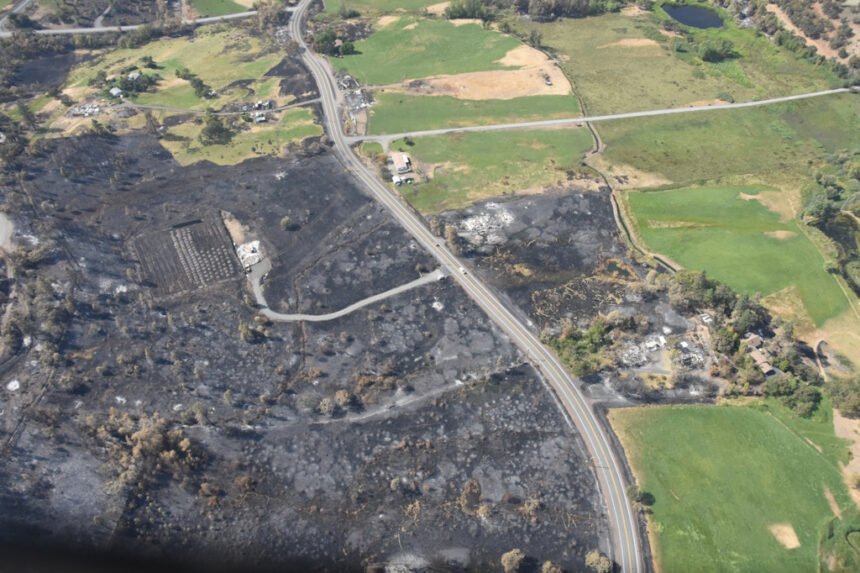NW Civil Air Patrol pilots join wildfire efforts

SALEM, Ore. (KTVZ) -- Flying is tricky due to smoke, temporary flight restrictions over wildfires and off-and-on rain showers, but four Oregon and one Washington Civil Air Patrol aircraft joined the effort to recover from devastating wildfires on Saturday.
Working with the Federal Emergency Management Agency and the Oregon Office of Emergency Management, CAP is tasked with photographing key infrastructure from the air to help assess damage caused by fires that have ravaged almost 1 million acres in the state this year.
Air crews composed of a mission pilot, an observer and an airborne photographer are taking on assignments all over Oregon.
Using high-resolution digital cameras, the highly trained CAP aircrews returned more than 151 images to emergency operations supervisors Friday. Eight sorties were flown Friday as the smoke started clearing and thundershowers dissipated.
“Conditions were challenging,” said 1st Lt Jonathan Ritchie, a pilot on Friday and Saturday sorties. “Low cloud layers interfered with access to target areas. Some crews could get to their target areas. It was a little bit challenging working around the TFRs (temporary flight restrictions). ATC (air traffic control) was very helpful in keeping us where we needed to be.”
“It is quite satisfying to be a pilot on these missions,” he said. “We do a lot of training to prepare for these kind of things. We have a great staff running the mission base to plan our sorties and keep us safe.”
Oregon CAP aircraft based in Hillsboro, Medford, Redmond, Salem and Vancouver, Wash., participated Friday. They flew assignments for the Beachie Creek Fire, the Riverside Fire, the Brittain Fire, the S. Oberchain Fire, and the Archie Creek Fire.
This was the fourth day of CAP participation. More than 33 CAP volunteers have worked on organizing, flying and recording activities. In addition, CAP has a couple of highly trained emergency services personnel that are imbedded with the OEM in Salem. They are responding to requests for air support and advising on other inter-agency cooperation.
Flying in the time of coronavirus adds complications, as members of the air crew need to follow special procedures to keep each other safe and protect the equipment. You cannot use normal sanitizing wipes on aircraft instruments and surfaces, for instance.
CAP in Oregon has 290 adult volunteers who train vigorously each year to be ready to help in situations like Oregon’s unprecedented onslaught of wild fires that have burned thousands of structures and displaced more Oregonians that any emergency in years.
CAP members train to FEMA standards, so they can operate jointly with other emergency agencies.
CAP also has 247 cadet members who train in leadership, character development, physical fitness and citizenship. Many of them train in emergency services as well, and participate in ground search and rescue and detecting emergency signals emitted by aircraft in distress.
About Civil Air Patrol
Established in 1941, Civil Air Patrol is the official auxiliary of the U.S. Air Force and as such is a member of its Total Force. In its auxiliary role, CAP operates a fleet of 560 single-engine Cessna aircraft and 1,944 small Unmanned Aircraft Systems (sUAS) and performs about 90% of continental U.S. inland search and rescue missions as tasked by the Air Force Rescue Coordination Center.
Often using innovative cellphone forensics and radar analysis software, CAP was credited by the AFRCC with saving 129 lives so far in fiscal 2020. CAP’s 60,000 members also perform homeland security, disaster relief and drug interdiction missions at the request of federal, state and local agencies.
As a nonprofit organization, CAP plays a leading role in aerospace education using national academic standards-based STEM (science, technology, engineering and math) education. Members also serve as mentors to nearly 25,000 young people participating in CAP’s Cadet Programs.
One of the premier public service organizations in America, CAP benefits the nation with an estimated economic impact of $209 million annually.